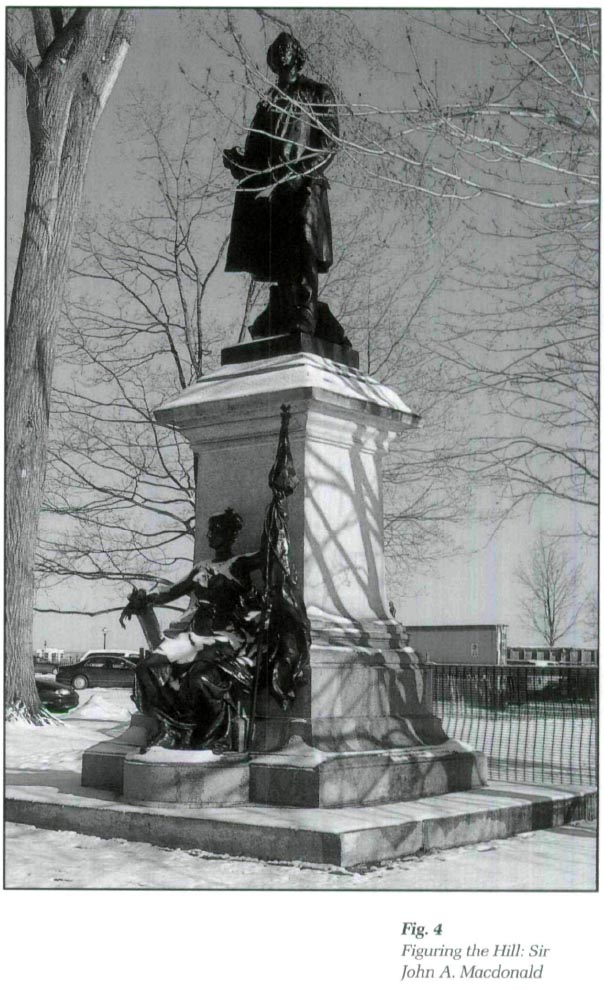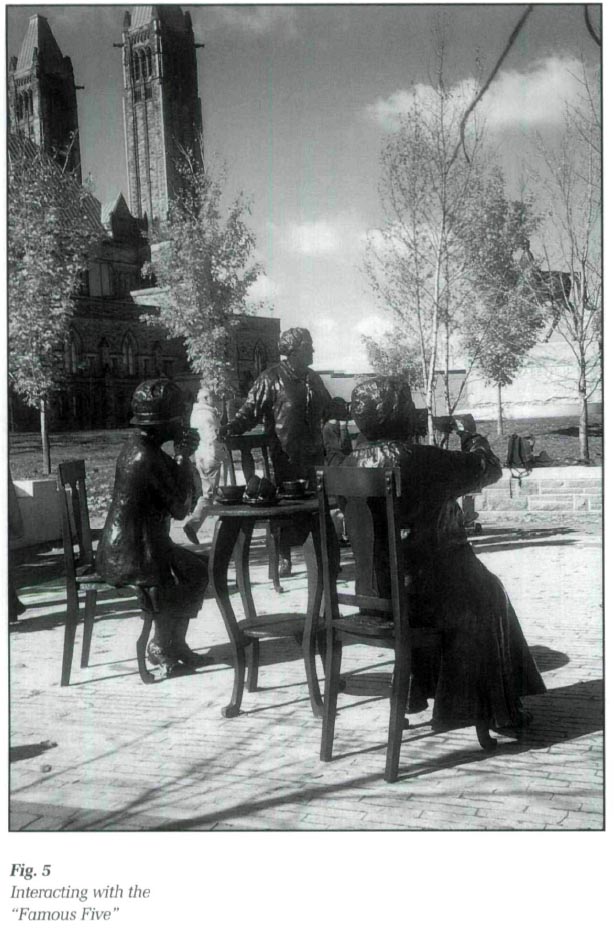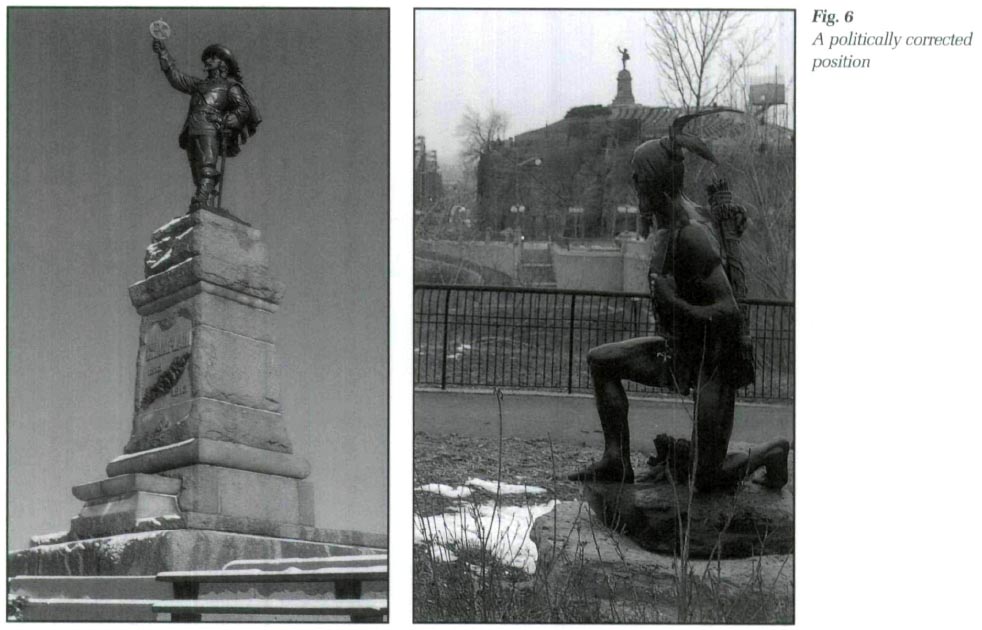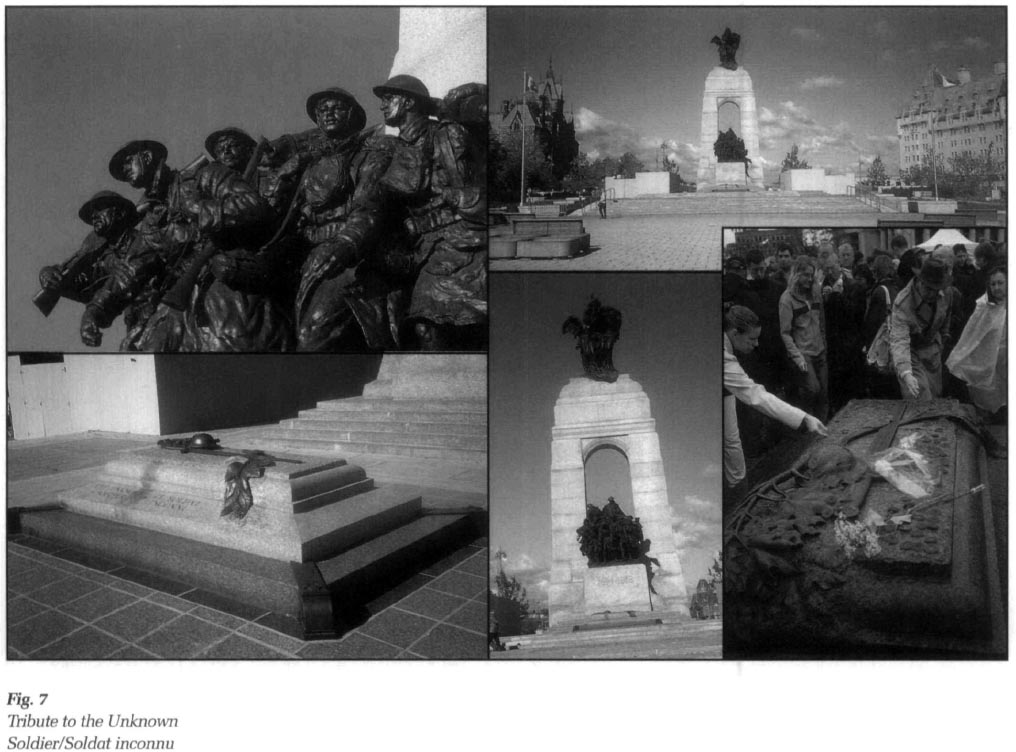Articles
The Cast[e]ing of Heroic Landscapes of Power:
Constructing Canada's Pantheon on Parliament Hill1
Abstract
This paper explores Canada's strategy of nurturing a collective memory and social cohesion by the construction of a memorial-complex in the evolving capitol-capital complex. It called for the representation of national narratives in monumental forms, the construction and consecration of a symbolic topography, and the performance of identity through commemorative activities. It is argued here that the ever-expanding pantheon of national heroes on Parliament Hill is intended to materialize the abstract ideas of the "nationalizing-state" as they evolved through the trajectory of dependent-colony, imperial-nation, state-nation, and consensual community. That is, the cultivation of a collective memory grounded in a mythic past, reified in the present, and projected into the future. The question is posed whether such strategies are sensitive to Canada's role in a globalizing world.
Résumé
Cet article se penche sur la stratégie de construction d'un complexe commémoratif au sein d'un ensemble capitole-capitale en évolution, qu'a utilisée le Canada pour alimenter la mémoire collective et favoriser la cohésion sociale. Cette stratégie reposait sur la représentation de récits nationaux sous forme de monuments, la construction et la consécration d'une topographie symbolique et la mise en scène de l'identité par des activités commémoratives. Les auteurs considèrent que le panthéon toujours grandissant de héros nationaux sur la colline du Parlement a pour fin de matérialiser les idées abstraites d'État nationalisâtes, qui ont évolué au fil des ans suivant la trajectoire menant de colonie dépendante à nation impériale, puis à nation-État et collectivité consensuelle. Il s'agit de la culture d'une mémoire collective ancrée sur un passé mythique, réifiée dans le présent et projetée dans l'avenir. La question est maintenant de savoir si de telles stratégies prennent en compte le rôle du Canada dans un contexte de mondialisation.
Kindling "Memory's Flame," 1927
1 In an age accustomed to commemorations, 1 July 1927 was a date not to be ignored — at least in Canada, and especially in Ottawa.2 The previous sixty years of Canadian statehood had been marked by a growing awareness of a monolithic national identity, albeit one attended by many challenges: lingering imperial connections, Anglo-French sensitivities, a bourgeoning ethnic pluralism, and the complexities of continentalism. All the more reason, therefore, to throw a big party to mark the Diamond Jubilee of Canada's rite of passage that had occurred sixty years earlier, on 1 July 1867.
2 The day's program proved to be a full one: the laying of a cornerstone of the new Confederation Block on Parliament Hill; the dedication of the Peace Tower carillon; the planting of a maple tree by the wife of the Governor General, Viscountess Willingdon; local school children singing patriotic songs in English and French; and the Governor General delivering a speech prepared by King George V that, in a signal demonstration of technological integration, was broadcast live across the nation.
3 Prime Minister William Lyon Mackenzie King was determined that his hero and political mentor, Wilfrid Laurier, would play a not-insignificant role in these celebratory events.3 Soon after he became prime minister in 1921, King had initiated the planning for a statue of Laurier on Parliament Hill and some forty sculptors submitted designs. The successful candidate, Montreal's Joseph-Emile Brunet, proposed an extensive terrace surmounted by a bronze figure of Laurier, and embellished with allegorical reliefs and carvings depicting new provinces, agricultural and industrial progress, and railway construction. This was too elaborate for King's idea of the man. He wanted a simple portrait-statue that captured the essence of the Laurier of later years: the elder statesman, experienced and wise. Brunet complied with his patron's wishes, but King did not get all that he wanted. His original plans called for the pairing of the Laurier statue with that of John A. Macdonald, the "two great leaders." They were to be located at either side of a central gateway to Parliament Hill, at the head of Metcalfe Street. But this was rejected. Rather, it was decided to position Laurier's statue at the southeast corner of Parliament Hill. Here he would stand, overlooking the Plaza in the centre of Ottawa, gazing out towards the distant Laurentians, and attracting the attention of visitors arriving by rail at the downtown station. The unveiling was to be the highlight of the official Jubilee celebrations on 1 July 1927.
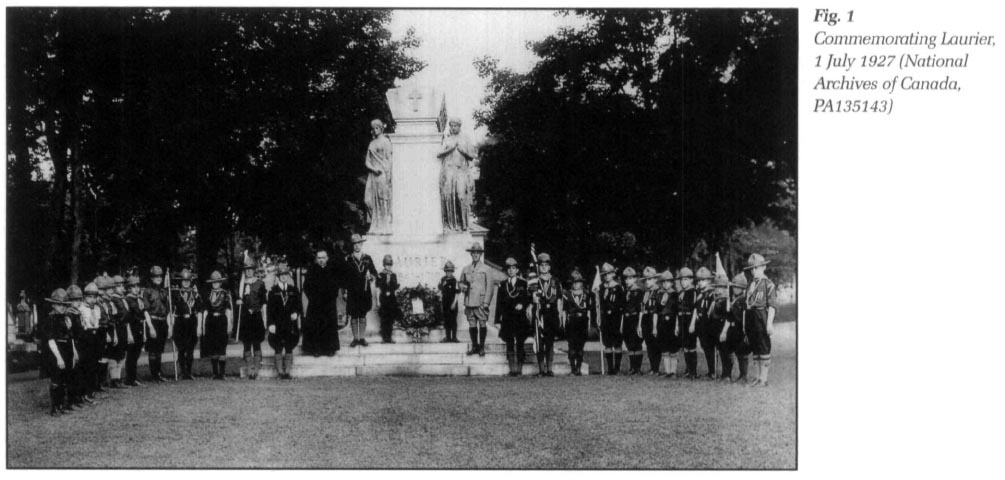 Display large image of Figure 1
Display large image of Figure 14 Given Laurier's constant advocacy of Canadian autonomy within the Empire, it is somewhat ironical that the planned date for the dedication of his statue was postponed to 3 August to ensure the presence of British royalty! Given Laurier's insistence that Canada should be an autonomous nation state with close, but not subservient connections to the British Empire, having to wait upon the British contingent would have irked him. But King had to content himself with limiting Laurier's presence in the jubilee celebrations to a ceremony at his tomb in Notre Dame cemetery (Fig. 1).4 Nevertheless, despite the delay, the eventual unveiling of Laurier's statue on 3 August provided yet another opportunity for the celebration of nationhood. Representatives of the Empire, leading political figures, and members of the Canadian elite were all in attendance. Indeed, it was argued that the ceremony involved "more eminent persons.. .than ever took part, in any event of a like nature, before or since Canada came into being."5 With "battalions" of movie cameras "entrenched" along Wellington Street to record the drama of the day, some 30 (XX) people "from all creeds and parties joined together un Parliament Hill to pay homage to the memory of Sir Wilfrid Laurier."6 They constituted the cast for the staged performance of processions, military bands. Hags, and salutes, with a script rendered in the charged oratory of commemoration. Ironically, all of this martial pomp and circumstance would have irked Laurier: clearly, King had ignored Laurier's will that stipulated that his Funeral not be accompanied by any military trappings.
5 It was to be a long day for all involved. It had started with a morning round of golf for the Prince of Wales. It continued with a speech to the Canadian Club by British Prime Minister Stanley Baldwin, a meeting of the Prince and veterans of the First World War, and the dedication of a shrine in the Memorial Chamber in the Peace Tower commemorating the Canadians who had died in that conflict. But the main event was the unveiling of the Laurier monument and the Prince of Wales directed his well-practised skills to the removal of the Union Jack that draped the statue (Fig. 2)7 The Governor General then invited King to address the assembled crowd. This was followed by the singing of "O Canada," speeches from Speaker of the House of Commons, Rodolphe Lemieux, and Baldwin, and a rendering of "God Save the King" by the Centenary Choir. Somewhat prosaically, the day's events were brought to a close by an official visit to the "World's Poultry Congress" where the British contingent viewed thousands of "barnyard exhibits."8
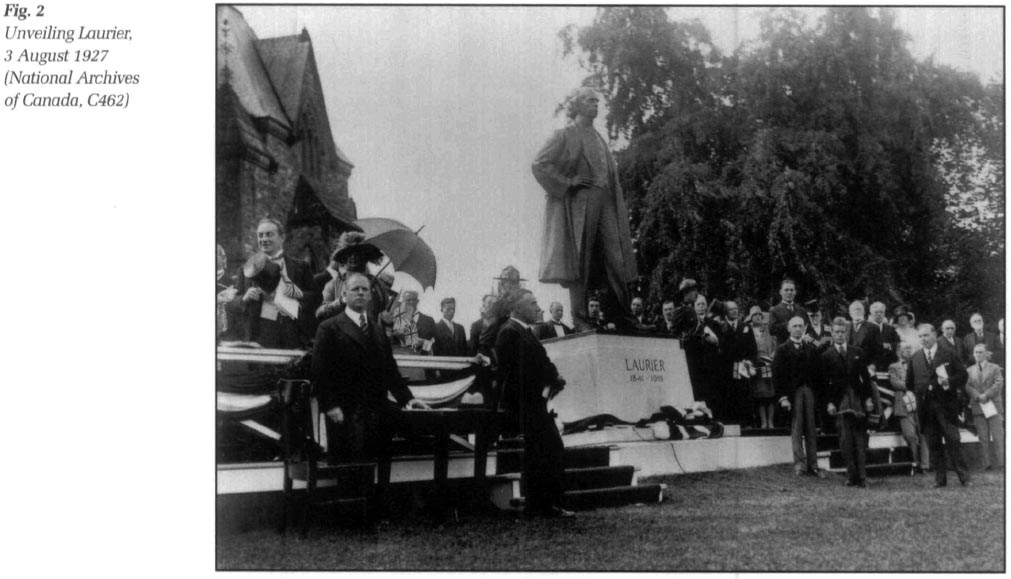 Display large image of Figure 2
Display large image of Figure 26 As an editorial in Toronto's Globe put it, the events of 3 August 1827 — poultry aside! — had "given Canada a chance to sort out her political heroes" and Laurier certainly merited recognition as "the main factor" in Canada's development.9 In particular, as Lemieux pointed out, monuments were central to the construction of a national identity: they were "reminders of a past which Canadian youth should ever keep before their eyes"; they would serve to "rekindle in their souls memory's flame whereby great teachings and profitable lessons were retained"; and
7 That is, history needed to be personified; ideologies and credos needed to be materialized; the national chronicle and pantheon had to be brought to the public eye. The overall theme of the commemorations on this day advanced a profound identification with place and communitv thought to be essential for a strong sense of national cohesion. Wilfrid Laurier was ideally suited to King's image of a heroic Canada. Indeed, the purpose of this paper is to demonstrate how King's state rituals of 3 August 1927 were more than a matter of bronze and granite and a dominant site. The choreography of the unveiling was intended to load the memorial-complex being constructed in the national capital with another layer of symbolic meaning. It would reinforce Canadians' collective memory of Laurier and propagate his imagination of the nation-state. It fitted into Canada's strategy of nurturing a collective memory and social cohesion through the representation of national narratives in monumental forms, the construction and consecration of a symbolic topography, and the performance of identity through commemorative activity. These need to be better understood.
National Pantheon, Historic Sights: Materializing Canada
8 The events of 1927 took place at the tale end of an age in which nationalism still privileged the emotional and exclusionary celebration of collective identity with mythic pasts and glorious futures.11 Ronald Rudin has drawn attention to "the wave of public commemoration that swept across the Western world at the turn of the twentieth century" in which heroes and great events "were celebrated through such devices as lavish parades, elaborate monuments, and theatrical re-enactments of pivotal moments in history."12 In an age where nation-states encountered the challenges of industrialization, secularization, and immigration, the provision of,
9 In particular, monumental sculpture represented the personification of the nation-state, the transmission of mythic histories, a material and visual connection with the past, and the legitimization of authority. Throughout the Western world, "statue-mania," the rage for commemorative statues, peaked in 1870-1914 and attained a social and political role not seen since the days of the Roman empire.14 For Yvonne Whelan,
Statuary was presented as allegorical statements of the national narrative and the abstract principles were intended to function as visual prompts for the collective memorizing of an official historical script.16 Portrait statuary of royalty, politicians, military heroes, and mythic figures joined flags and anthems, school curricula and national museums, coins and stamps in the toolbox of nationalism. Taken together, they produced what Alan Gordon has called a "mental historical geography" in which ideology is played out in geography: "geography mates with public memory to gather shared memories into a coherent, national past."17 The complex realities of an ever growing diversity were to be overcome by constructing iconic landscapes and narratives intended to nurture a cohesive collective memory and solidarity.18
10 Ever since Confederation in 1867, Canada has applied several strategies in attempting to construct a national landscape. Perhaps what has received most attention has been the transformation of the nation's natural setting into a symbolically loaded terrain. The development of a powerful emotive attachment to the north and a wilderness aesthetic was so successful that they were transformed into iconic statements of Canadian national identity. And while the Group of Seven were carving out a northern inscape in a mythic geography, historians, poets, and politicians were populating a mythic history with metanarratives of a progressive patriotic chronicle.19
11 Similarly, federal, provincial, and private institutions have attempted to establish a national metanarrative through various initiatives in school curricula, popular histories, journals, radio shows, and film. Other agencies have been involved in the development of a public landscape in which the dominant ideology of the state was rendered in terms of symbolically loaded sites: the Quebec Landmark Commission (1907); the National Battlefields Commission (1908); the Historic Sites and Monuments Board (1919); and, the Quebec Commission des monuments historiques (1922). Further, thousands of community-based First World War memorials and the national war memorials at Vimy Ridge and Ottawa also contributed to the spatial diffusion of the landscape of sovereignty. Finally, a whole range of government and elite agencies were involved in nurturing a Canadian national memory: National Archives (1872); Canadian Club (1893); Champlain Society (1905); Dominion Parks Branch (1911); Canadian Broadcasting Commission (1932); National Film Board (1939); and, the Canada Council (1957).20
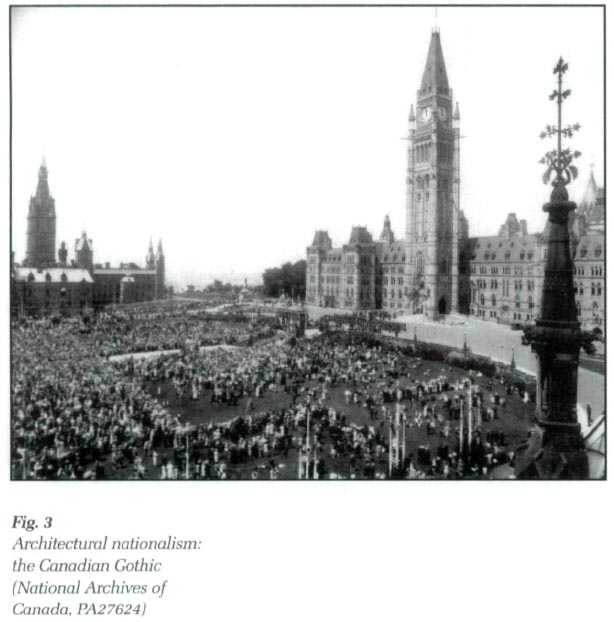 Display large image of Figure 3
Display large image of Figure 312 Like other political regimes, Canada also developed its capital complex.21 Following Queen Victoria's final decision of 1859, Ottawa prepared itself for its new role as national capital.22 It was to be both a focal point and materialization of Canada's new constitutional status: that is, a symbolic space that reflected national ambitions and annexed other cultural spaces into the national domain.23 Canada's cultural plurality required "a contrived metaphor of unity."24 For some, the task was to transform a "Westminster in the wilderness" into what Laurier dreamed it to be, the "Washington of the north."25 The preliminary landscape plan prepared in 1903 by Frederick G. Todd called for parks and other improvements that would enhance Ottawa's role as the Dominion capital:
He was also explicit about the space requirements for such a city:
Initially, the capital-complex was planned and executed primarily by the Department of Public Works but several other agencies were charged with the task of creating a city worthy of a capital, and a capital worthy of the nation: the Ottawa Improvement Commission (OIC) in 1899; the Federal District Commission (FDC) in 1927; and the National Capital Commission (NCC) in 1959. Throughout these years, these various agencies have struggled with concepts of the "citadel," the "capital-T form," the "City Beautiful," and the "Rational City."28 At issue has also been the tension between the constraints of site, functional needs, and the symbolic representation of political process and national dream.
13 But it was not simply a matter of vistas and arrangements of public buildings. There were other initiatives in the creation of a symbolic political space. As Whelan argues, "If the city is a repository of collective memory, then public statues make an important contribution to its memory bank while focusing attention on specific places and events in highly condensed, fixed and tangible sites." If this is true for cities in general, it is particularly true of capital cities.29 Accordingly, the Ottawa capital-complex came to be loaded with iconic renderings in allegorical terms of the nation's progress from colony, through empire, to state-nation. (I use the term "state-nation" and "nationalizing-state" to emphasize the role of the state in moving beyond new constitutional compromises by nurturing some sense of belonging, of an imagined community.) Three nested symbolic spaces may be recognized.
"An Epic in Stone": The Parliament Buildings
14 Somewhat paradoxically, and after much deliberation, Canada's Parliament was rendered in an architectural style that was unabashedly associated with a British high-imperial interpretation of "civil Gothic" (Fig. 3). At that time, this High Victorian Gothic Style was seen as yet another link with Great Britain in general and a Westminster democracy in particular. Eventually, however, the complex was transmogrified into a distinctive expression of Canadian identity as a rising tide of Canadian nationalism appropriated it for its own.30 Moreover, the Parliament Buildings were soon taken to be a metaphor for a confident and expansive nation-state, "a symbol of the bold vision and confidence that had supposedly marked the founding of the country."31 The Canadian poet-cum-historian, Sir Wilfrid Campbell, contributed to this more nativist interpretation by asserting that the Parliament Buildings were "epics in stone" for our Celtic, Saxon, Norman people that were "emblematic of our common ideal, our common artistic sense, our common ancestry, and our common Christianity."32 Whatever the iconography, the building was commenced in 1860, ready for the pragmatics of its governmental role by 1865, and by 1870 the capital of the new Dominion was firmly established in Ottawa's landscape in three locales: Parliament Hill; Major's Hill Park; and Rideau Hall.
15 Following a fire on 3 February 1916, the cornerstone of the new Centre Block was relaid on 1 September 1916, completed by 1920, and the Peace Tower added in 1927 as a memorial to the dead of the First World War. Three Gothic arches accommodated a blatantly inclusive iconography with the coats of arms of provinces, regional fauna and flora, a lion holding the British flag, and a unicorn brandishing the fleur-de-lis. Within the building itself, an array of monuments, busts, plaques, and paintings were assembled as part of the display of the national chronicle. When taken together, the assemblage of buildings constituted an architectural statement of mythologized origins and of a dreamed-of future.
"A National Pantheon": Parliament Hill
16 For some twenty years, the grounds surrounding Parliament were figureless. Gradually, however, they became colonized by a national pantheon of historical figures in bronze and marble. Further, the hill became a stage for a national program of pageants, commemorations, unveilings, state funerals, and celebrations that focused the attention of Canadians on this place and what it represented.
17 In 1885, Sir Georges-Etienne Cartier was the first to be memorialized, followed by Sir John A. Macdonald in 1895 (Fig. 4). On the latter occasion, the need to add other figurative statements of the national mission became a matter of comment. The Toronto Globe's report of the unveiling of the statue of Macdonald remarked on the recent erection of statues of the marquis de Levis in Quebec and of Maisonneuve in Montreal.33 It argued that "we have reached that period in our history when we feel that it is good to commemorate the deeds of the great leaders who have acted their parts in our country's story," and complained that, other than the monument to Carrier, the "National Government has done but little in this direction." The Globe attributed the more active role of the Government of Quebec to "the French artistic instinct," observing that there were "probably ten monuments in the Province of Quebec for every one in this Province, and some of those we have here, such as that to Lalemant and Brébeuf, have been erected by the enthusiasm of our French-Canadian fellow-citizens." Commending government for "having inaugurated a good work," the article argued that there were "other eminent Canadians whose life work deserves to be remembered and honoured by the nation." In a predictably partisan voice, it recommended that the renowned Liberals, George Brown and Alexander Mackenzie, "be preserved in enduring bronze in the federal capital" to counter the rather "one-sided" story of Canadian history represented by the figures of their Conservative protagonists, Macdonald and Cartier. However, there was a counter view to this prevailing enthusiasm for public statuary as the appropriate device for materializing history. At least one voice preferred plaques and tablets to statues:
18 Portrait statuary continued infavour. But the next figure to be cast in bronze was not to be another landmark of Canadian nationalism. Rather, the ceremony accompanying the unveiling of the statue of Queen "victoria in 1901 was couched in the rhetoric of a Canadian identity tied to the glories of empire and a worldwide Anglo-Saxonism.35 However, a succession of Canadian notables soon followed: Alexander Mackenzie (1901); George Brown (1913); Robert Baldwin and Sir Louis-Hippolyte Lafontaine (1914); Thomas D'Arcy McGee (1922); Sir Wilfrid Laurier (1927); Sir Robert Borden (1957); William Lyon Mackenzie King (1968); John Diefenbaker (1986); Lester B. Pearson (1990). But not Louis Saint-Laurent: he's outside the Supreme Court. Nor are Mackenzie Bowell, or Richard Bennett, or Arthur Meighen there: matters of aesthetics versus realism have interfered with their inclusion.36 As for Trudeau, Clarke, Turner, Mulroney, Campbell, and Chrétien, they are all waiting in line.
19 Hitherto reserved for royalty. Fathers of Confederation, and prime ministers, other current suggestions regarding the addition to the pantheon are proving to be contentious. Thus, if passed, the proposed private member's bill to pardon Louis Riel and make him a Father of Confederation would entitle him to join the monumental pantheon on the Hill.37 No doubt, given the reaction to statues of Riel formerly located within the provincial capital-capitol complexes at Winnipeg and Regina, such a move would provoke considerable debate and opposition.38
20 Similarly, the unveiling of the monument on 18 October 2000 to the "Famous Five" — Emily Murphy, Nellie McClung, Henrietta Muir Edwards, Louise McKinney, and Irene Parlby — broke with the traditional reservation of Parliament Hill for Fathers of Confederation, monarchy, and prime ministers.39 It aroused the ire of those challenging the moral probity of some of the five, while a representative of REAL Women has gone further and complained that it is a misguided attempt to create "Canadian heroines" where none exist! For many other Canadians, however, everything about the initiative was appropriate: the unveiling on 18 October 2000 was the same date of the famous "Persons Case" seventy-one years earlier; of the three prominent dignitaries present—the Governor General, the Prime minister, and the Chief Justice of the Supreme Court—two were women; and, the prestigious location was said to be appropriate as "the essence of what was done is what warrants their presence on Parliament Hill because it is Parliament Hill and this Parliament which they changed."40 Finally, the sculptor, Barbara Paterson, eschewed the traditional elevation and heroic postures of so much political statuary and purposefully rendered an interactive model in which the ground level access and informal pose of "The Five" that invites a people's conversation with the subjects and their ideas (Fig. 5).
"A Path of Heroes": The Capitol Complex
21 A third, outer zone of commemoration surrounds Parliament Hill: Cut Knife Hill, Riel Rebellion; Sir Galahad;41 Samuel de Champlain; the National War Memorial; Terry Fox; the Canadian Peace-keepers; and many others scattered around within the sound of the chimes of the Peace Tower carillon. Here too, the process of commemoration, myth-building, and state-nation building has attracted some rancour.
22 In 1915, a monument to one of Canada's most celebrated heroes, Samuel de Champlain, was unveiled before a large throng, overlooking the Ottawa River. Again, Wilfrid Campbell was called upon to compose a poem for the occasion, and many speakers eulogized the popularly acclaimed founder of Canada. Sculptor Hamilton MacCarthy cast Champlain in heroic pose with astrolabe held high and a faithful Native amanuensis crouched at his feet.42 The latter has proven to be as problematic as the rendering was stylized. Throughout North America, monumental iconography representing Native-European interaction has always rendered Native Americans as adversaries or as "infinitely computable totemic figures," and never as having had autonomous histories and cultural identities.43 It is not surprising, therefore, that in 1997 the Chief of the Assembly of First Nations, Ovide Mercredi, argued that the kneeling posture of "the life-size bronze Indian at the base of the monument" presented a demeaning image of aboriginal people.44 As Plains Crée sculptor Lloyd Pinay put it, "I don't know a Native person who isn't offended by that statue. I wonder how people would feel if it was a gigantic Indian standing over a tiny Champlain."45 In the spirit of the prevailing political correctness, Champlain's partner has now been distanced from him, albeit to an even lower location (Fig. 6).46
23 Equally contentious has been then Heritage Minister Sheila Copps's 1997 proposal for "a path of heroes" to encircle Parliament Hill, follow Wellington Street, cross the Portage Bridge to Laurier Avenue in Gatineau, and back to Sussex Drive.47 Copps's faith in "the power of images to fire Canadian imaginations" has prompted consideration of such worthies as Laura Secord, Rick Hansen, Nellie McClung, Tecumseh, and Billy Bishop. Predictably, these new initiatives are prompting much discussion of the contemporary relevance of monumentalism, or of the appropriateness of those being memorialized. Some are not enthusiastic. Pierre Berton has pronounced that "money spent on putting up statues could be better spent helping those who need help." Alex Colville objected to his own inclusion because "I think it would be a foolish idea For one thing, I know it would be a bad sculpture, done by some hack."48
24 But another proposal did not receive much opposition. In May 2000, the remains of an unknown soldier were flown from France to lie in state in the Parliament Buildings prior to being interred with full military honours at the foot of the national War Memorial in Confederation Square.49 Initiated by the Royal Canadian Legion and supported by the departments of Veterans Affairs and National Defence, this memorial to the "Unknown Soldier/Soldat inconnu" was meant to be symbolic of the 110 000 Canadians who died in the wars of the twentieth century and the 27 000 who lie in unknown graves (Fig. 7). The monument consists of a plain granite sarcophagus modelled after the altar at Vimy, with a sculpted bronze lid decorated by a helmet, maple leaves, and a laurel wreath. In an emotional and dramatic ceremony, the remains were interred with soil collected from Canada's ten provinces, three territories, and Vimy Ridge.50 Appropriately, a year later, on Aboriginal Day in 2001, another evocative war memorial was dedicated further along Elgin Street. Loaded with First Nations iconography, Lloyd Pinay's creation commemorates the service and sacrifices of Canada's aboriginal peoples in the nation's wars51 (Fig. 8).
Conclusion: Shifting Grounds
25 In commemorating particular individuals, events, or diagnostic concepts, "public monuments are not merely ornamental features of the urban landscape but rather highly symbolic signifiers that confer meaning on the city and transform neutral places into ideologically charged sites."52 Clearly, this is the case with the "people's space" of Ottawa's Parliament Hill, which is continuing to play an important symbolic role in Canada's strategies of state-nationalism. The capital-capitol complex consists of an expanding pantheon of national heroes who personify the abstract ideas of the nationalizing-state as they evolved throughout the 1867-2000 trajectory of dependent-colony, imperial-nation, nationalizing-state, and consensual-community.53 That is, the cultivation of a "collective memory" grounded in a mythic past, reified in the present, and projected into the future.
26 But identity and sense of belonging in the modern world are complex concepts and increasingly uneasy with simple meta-narratives. Most people are effected by plural connections. Class, gender, religion, and ethnicity compete with local, regional, and national associations. Moreover, globalization and migration are producing trans-national identities that are challenging the liberal, nation-bound concept of citizenship and sovereignty. Charles Taylor has argued for the nurturing of a "deep diversity" in which we learn "how to live with these multiplicities of identity and yet achieve some kind of common understanding."54 Similarly, Will Kymlicka calls for a deep "cultural pluralism" that arises from "a recognition of the diversity of the histories and backgrounds we come from."55 Recognizing Canada's pluralism, Daniel Francis has called for the invention of new national narratives.56 And finally, others are seeking the means to achieve a "social cohesion" that is defined as "the ongoing process of developing a community of shared values, shared challenges and equal opportunity within Canada, based on a sense of trust, hope and reciprocity among all Canadians. ' 57 As Richard Gwyn has noted, as members of the "first postmodern state," Canadians must recognize that these shared values are "our substitutes for conventional commonalities of ethnicity and history" that serve to bind us together into "a political community, not a sociological one."58
27 So how do we interpret the meaning, significance, and effectiveness of the monumental landscapes of power that have materialized around us? Henri Lefebvre warns that representational space in general, and monumental space in particular, constitutes a deceptive and tricky trompe-l'oeil that cannot be approached by semiological and symbolic interpretation alone: it is a product of extensive webs of meaning.59 Further, despite their materials, monuments are not timeless. Some are the centres of ritualized remembrance and performance. Some receive the ultimate insult of neglect, anonymity, and disinterest. In others, contemporary events challenge the original values of the site, appropriate it for new causes, and thus revitalize them as visual statements of contemporary values. Indeed, the "sustaining illusion" of monuments is their attempt to concretize memories of heroes, ideals, and myths in the landscape while, in reality, they are as transient as the political, historical, and aesthetic realities of the time of their erection.60 Recognizing this, monuments and their associated commemorations are best thought of as devices of communication rather than aesthetic representations. That is, they perform an action, that is governed by conventions, contribute to the formation of social relationships, and often involve the sanction of prevailing systems of power.61 Indeed, it is the nature of the public reaction to monuments that determines whether or not they serve as passive visual statements contributing to "social cohesion," or as active elements in a public discourse of redefinition (Fig. 9). And, in a constitutional democracy, this may be the best way to approach the past and current discourses associated with the establishment of the landscape of sovereignty on Parliament Hill, and their appropriateness for a forward-looking and accommodating Canadian polity in a globalizing world.
